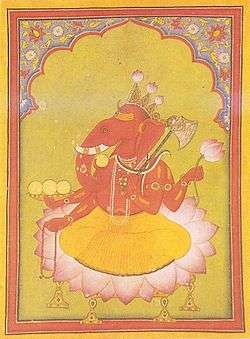Ganesh Chaturthi
| Ganesh Chaturthi | |
|---|---|
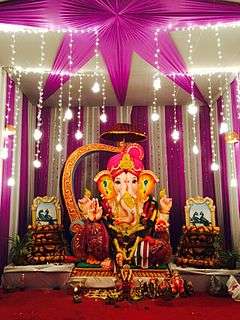 Ganesha Festival, Hyderabad | |
| Official name | Ganesha Chaturthi/Vinayaka Chaturthi |
| Also called | Chavath ,Chavathi, varasiddhi vinayaka vratam,pillayar chaturthi,lambodara pirnalu, Ganeshotsav |
| Observed by | Hindus |
| Type | Religious, folk |
| Celebrations | Pavilions, street processions, idol immersion |
| Begins | Bhadrapada shukla chaturthi |
| Ends | Varies |
| Date | August, September |
| 2015 date | 17 September |
| 2016 date | 5 September |
| 2017 date | 25 August |
| Frequency | Annual |
Ganesh Chaturthi (also known chavathi Gaṇēśa Chaturthī or Vināyaka Chaviti) is the Hindu festival celebrated in honour of lord Ganesh. This is a very auspicious day celebrated to pray to the god so that every new activity that is started is successfully completed without any obstacles .(Vighna = Obstacle). He is the God of knowledge. (Knowledge = gyan)
Chaturthi (Sanskrit: चतुर्थी) means "fourth day" or "fourth state". Celebrations are traditionally held on the fourth day of the second fortnight (Shukla Chaturthi) in every month and is also known as "Vinayaka Chathurti", but the biggest annual celebration in the month of Bhaadrapada in the Hindu calendar, usually is August or September in the Gregorian calendar. Badrapad corresponds to Virgo (simha/avani-tamil) in solar calendar. The festival generally lasts ten days, ending on the fourteenth day of the fortnight.
The festival is celebrated by families at home, by people at their places of work and in public. The public celebration involves installing clay images of Ganesha in public pandals (temporary shrines) and group worship. At home, an appropriately-sized clay image is installed and worshipped with family and friends. At the end of the festival, the idols are immersed in a large body of water such as the sea, river or a lake. The clay idols disintegrate over time in the water.
It is celebrated throughout India, especially in the states of Maharashtra, Telangana and Andhra Pradesh. There is a grand celebration in the state of Maharashtra and Telangana by traditional instrument called dhol and tasha. It is also celebrated in the other parts of India such as Gujarat, Karnataka, Tamil Nadu, Kerala, Goa,[1] Odisha, Madhya Pradesh, Chhattisgarh and other parts of western[2] and southern India.[3] Abroad, Ganesha Chaturthi is observed in Nepal and by the Hindu diaspora in the United States, Canada and Mauritius.[4] All the big Ganesh statues are made in Andhra Pradesh.
History
Although it is unknown when (or how) Ganesha Chaturthi was first observed,[5] the festival has been publicly celebrated in Pune since the era of Shivaji (1630–1680, founder of the Maratha Empire).[5] The Peshwas (hereditary administrators of the empire from 1718 until its end in 1818) encouraged the celebrations in their capital, Pune, since Ganesha was their family god (Kuladevata).[5] With the fall of the Peshwas, the Ganesha festival lost state patronage and became a private family celebration in Maharashtra until its revival by Indian freedom fighter and social reformer Lokmanya Tilak.[5]
The current Maharashtra public festival was introduced in 1892 by Bhausaheb Laxman Javale ( also known as Bhau Rangari), who installed the first sarvajanik (public) Ganesha idol after he met with Balasaheb Natu and Krishnajipant Khasgiwale at his home. When he visited the Maratha-ruled state of Gwalior, Khasgiwale saw the traditional public celebration and brought it to the attention of his friends in Pune.[6] In 1893, Tilak praised the celebration of sarvajanik Ganesha utsav in his newspaper, Kesari, and the following year he installed a Ganesha idol in the Kesari office; his efforts transformed the annual domestic festival into a large, well-organised public event.[7] Tilak recognized Ganesha's appeal as "the god for everybody",[8][9] popularising Ganesha Chaturthi as a national festival to "bridge the gap between Brahmins and 'non-Brahmins' and find a context in which to build a new grassroots unity between them", generating nationalistic fervour in the Maharashtrian people to oppose British colonial rule.[10][11] He was the first to install large public images of Ganesha in pavilions, and established the practise of submerging the idols in rivers, the sea or other bodies of water on the tenth day of the festival.[12]
Encouraged by Tilak, Ganesh Chaturthi facilitated community participation and involvement in the forms of intellectual discourse, poetry recitals, plays, concerts, and folk dances. It was a meeting ground for people from all castes and communities at a time when the British discouraged social and political gatherings to control the population.[13]
In Goa, Ganesha Chaturthi predates the Kadamba era. The Goa Inquisition had banned Hindu festivals, and Hindus who did not convert to Christianity were severely restricted. However, Hindu Goans continued to practice their religion despite the restrictions. Many families worship Ganesha in the form of patri (leaves used for worshiping Ganesha or other gods), a picture drawn on paper or small silver idols. In some households Ganesha idols are hidden, a feature unique to Ganesh Chaturthi in Goa due to a ban on clay Ganesha idols and festivals by the Jesuits as part of the Inquisition.[14] Unlike the Maharashtra festival, Ganesh Chaturthi is more of a family affair; gatherings of 1,000 or more celebrate the festival in their ancestral homes.[15]
Celebrations
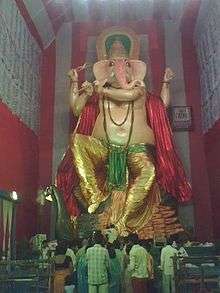
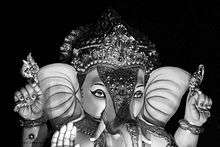
Public Preparations for the festival begins months ahead. They are usually funded by local residents, businesses and community organizations.The idol making in Maharashtra usually begins with "Padya pooja" or worshipping the feet of Lord Ganesh. The idols are brought to "pandals" or temporary structures usually 15–20 days before. The pandals have elaborate decoration and lighting.
At home the festival begins with the purchase and then the ceremonial installation of a clay murti (idol). Families decorate a small, clean corner with flowers and other colourful items before installing the idol. When the idol is installed, it and its shrine are decorated with flowers and other materials.
In preparation for the festival, artisans create clay models of Ganesha for sale. The idols range in size from 3⁄4 inch (1.9 cm) for homes to over 70 ft (21 m) for large community celebrations.[16] The date for the festival is usually decided by the presence of Chaturthi Thithi. The festival is held during "Bhadrapada Madyahanaa Purvabaddha". If the chaturthi thiti begins at night on previous day and gets over by morning on next day then the next day is observed as vinayaka chaturthi. In the consecration ceremony, a priest performs a Prana Pratishtha to invite Ganesha into the idol. This is followed by the 16-step Shodashopachara ritual,[17] (Sanskrit: Shodash, 16; Upachara, process) during which coconut, jaggery, modaks, durva grass and red hibiscus flowers are offered to the idol. Depending on the region of India,during the ceremony, hymns from the Rigveda, the Ganapati Atharvashirsa, the Upanishads, and the Ganesha stotra (prayer) from the Narada Purana are chanted.In Maharashtra, Aartis are performed with friends and family, typically in the morning and evening.
India
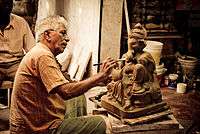

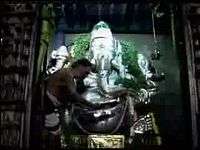
In India, Ganesha Chaturthi is primarily celebrated at home and in public by local community groups in the central and western states of Madhya Pradesh, Maharashtra,Gujarat and Goa and the southern states of Karnataka, Kerala, Andhra Pradesh, Telangana, and Tamil Nadu.
At home
At homes in Maharashtra, families install small clay statues for worship during the festival. The idol is worshiped in the morning and evening with offerings of flowers, durva(strands of young grass), karanji and modaks.[18][19] The worship ends with the singing of an aarti in honour of Ganesha, other gods and saints. In Maharashtra the Marathi aarti "Sukhakarta Dukhaharta", composed by the 17th century saint, Samarth Ramdas is sung.[20] Family traditions differ about when to end the celebration. Domestic celebrations end after 1 1⁄2, 3, 5, 7 or 11 days. At that time the idol is ceremoniously brought to a body of water (such as a lake, river or the sea) for immersion. Due to environmental concerns, a number of families now avoid bodies of water and let the clay statue disintegrate in a barrel of water at home. After a few days, the clay is spread in the home garden. In some cities a public, eco-friendly process is used for the immersion.[21] In Maharashtra, Ganeshotsav also incorporates other festivals, namely Hartalika and the Gauri festival, the former is observed with a fast by women on the day before Ganesh Chaturthi whilst the latter by the installation of idols of Gauris.[22]
In Goa, Ganesh Chaturthi is known as Chavath in Konkani and Parab or Parva ("auspicious celebration");[23] it begins on the third day of the lunar month of Bhadrapada. On this day Parvati and Shiva are worshiped by women, who fast.[1] Instruments such as ghumots, Crash cymbals (टाळ (taal) in Marathi and झान (Zaan) in Konkani) and pakhavaj (an Indian barrel-shaped, two-headed drum) are played during the ceremonies.[24] The harvest festival, Navyachi Pancham, is celebrated the next day; freshly-harvested paddy is brought home from the fields (or temples) and a puja is conducted. Communities who ordinarily eat seafood refrain from doing so during the festival.[1]
In Karnataka the Gowri festival precedes Ganesha Chaturthi, and people across the state wish each other well. In Andhra Pradesh, Ganesha idols of clay (Matti Vinayakudu) and turmeric (Siddhi Vinayakudu) are usually worshiped at home with plaster of Paris idols.
In public

Public celebrations of the festival are popular, and are organised by local youth groups, neighborhood associations or groups of tradespeople. Funds for the public festival are collected from members of the association arranging the celebration, local residents and businesses.[25] The Ganesha idols and accompanying statues are installed in temporary shelters, known as mandaps or pandals. The festival features cultural activities such as singing, theater and orchestral performances and community activities such as free medical checkups, blood-donation sites and donations to the poor. Ganesh Chaturthi, in addition to its religious aspects, is an important economic activity in Mumbai, Pune, Hyderabad, Bangalore and Chennai. Many artists, industries, and businesses earn a significant amount of their living from the festival, which is a stage for budding artists. Members of other religions also participate in the celebration.[26][27][28]
In Tamil Nadu the festival, also known as Vinayaka Chaturthi or Pillayar Chaturthi, falls on the fourth day after the new moon in the month of Āvaṇi in the Tamil calendar. The idols are usually made of clay or papier-mâché, since plaster of Paris idols have been banned by the state government.. Idols are also made of coconuts and other organic products. They are worshiped for several days in pandals, and immersed in the Bay of Bengal the following Sunday. In Kerala the festival is also known as Lamboodhara Piranalu, which falls in the month of Chingam.[29] In Thiruvananthapuram a procession marches from the Pazhavangadi Ganapathi Temple to Shankumugham Beach, with tall statues of Ganesha made from organic items and milk immersed in the sea.[30]
Abroad
Ganesha Chaturthi is celebrated in the UK by the migrant Hindu population and the large number of Indians living there. The Hindu Culture and Heritage Society, a Southall-based organisation, celebrated Ganesha Chaturthi for the first time in London in 2005 at the Vishwa Hindu Temple; the idol was immersed in the River Thames at Putney Pier. Another celebration, organised by a Gujarati group, has been celebrated in Southend-on-Sea and attracted an estimated 18,000 devotees.[31] Annual celebrations are also held on the River Mersey in Liverpool.[32][33]
The Philadelphia Ganesha Festival is one of the most popular celebrations of Ganesha Chaturthi in North America,[34] and it is also celebrated in Canada, Mauritius, Malaysia and Singapore. The Mauritius festival dates back to 1896, and the Mauritian government has made it a public holiday.[35] In Malaysia and Singapore, the festival is more commonly known as Vinayagar Chaturthi because of the large Tamil-speaking Hindu minority.[36]
Foods
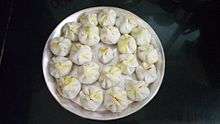
The primary sweet dish during the festival is modak (modak in Marathi and Konkani, modakam or kudumu in Telugu, modaka or kadubu in Kannada, kozhakatta or modakkam in Malayalam and kozhukattai or modagam in Tamil). A modak is a dumpling made from rice or wheat flour, stuffed with grated coconut, jaggery, dried fruits and other condiments and steamed or fried. Another popular sweet dish is the karanji (karjikai in Kannada), similar to modak in composition and taste but in a semicircular shape.This sweet meal is called Nevri in Goa and is synonymous with Ganesh festival amongst the Goans and the Konkani diaspora.[37]
In Andhra Pradesh and Telangana modak, laddu, vundrallu (steamed, coarsely-ground rice-flour balls), panakam (a jaggery-, black pepper- and cardamom-flavored drink), vadapappu (soaked moong lentils) and chalividi (a cooked rice flour and jaggery mixture) are offered to Ganesha. These offerings are known as naivedya, and a plate of modak traditionally holds 21 pieces of the sweet. In Goa, modak and a Goan version of idli (sanna) is popular.[38]
Environmental impact
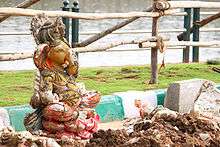
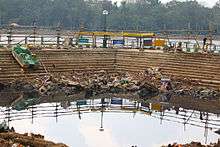

The festival has environmental impact due to the immersion of plaster-of-Paris idols in water bodies. Traditionally, idols were sculpted from mud taken from nearby bodies of water; after the festival they were returned to their source, a cycle meant to represent the natural cycle of creation and dissolution.
As the commercial production of Ganesha idols increased, earthen or "natural" clay (shaadu maati in Marathi and banka matti in Telugu) was replaced by plaster of Paris. Although the man-made plaster is easier to mould, lighter and less expensive than clay, it is non-biodegradable. The paint used to decorate the plaster idols contains heavy metals such as mercury and cadmium, which pollute the water. In addition, the non-biodegradable accessories adorning the idol accumulate in beach sand.[39]
In Trinidad and Tobago, Radio Jaagriti has educated the public on the environmental implications of plaster-of-Paris models and clay idols of Ganesha have been encouraged for immersion to prevent environmental damage. In Goa the sale of plaster-of Paris Ganesha idols has been banned by the state government and celebrants are encouraged to buy traditional, artisan-made clay idols.[40] Recent initiatives to produce clay Ganesha idols in Hyderabad have been sponsored by the Andhra Pradesh Pollution Control Board.[41]
To address religious sensitivities, some temples and spiritual groups have taken up the cause.[42]
Gallery
 Ganesh Idol at a pandal in Hyderabad
Ganesh Idol at a pandal in Hyderabad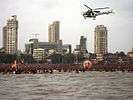 An Indian Coast Guard helicopter patrols Girgaum Chowpatty during the Ganesha immersion
An Indian Coast Guard helicopter patrols Girgaum Chowpatty during the Ganesha immersion Street festivities in Hyderabad during the festival
Street festivities in Hyderabad during the festival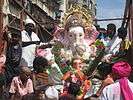 Ganesha procession in Mumbai before immersion
Ganesha procession in Mumbai before immersion Ganesh festival in Hyderabad
Ganesh festival in Hyderabad Immersion of idols at Foreshore Estate in Chennai
Immersion of idols at Foreshore Estate in Chennai- A small clay Ganesha idol in a home during the festival
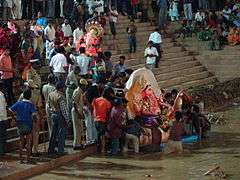 Immersion of idol in Sankey Tank, Bangalore
Immersion of idol in Sankey Tank, Bangalore Immersion in Hyderabad using a crane
Immersion in Hyderabad using a crane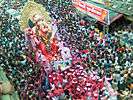 Ganesha idol immersion procession in Lalbaug, Mumbai
Ganesha idol immersion procession in Lalbaug, Mumbai A Ganesh Idol during immersion in Hyderabad
A Ganesh Idol during immersion in Hyderabad- Immersion procession in the Guruji Talim mandal of Pune
See also
References
- 1 2 3 "GANESH CHATURTHI or CHOVOTH". http://www.goatourism.gov.in. Government of Goa. Retrieved 23 August 2014. External link in
|website=(help) - ↑ "Ganesh Chaturthi". Encyclopedia Britannica.
- ↑ Administrator. "Incredible India – Ganesha Chaturthi, Maharashtra, Tamil Nadu, Andhra Pradesh, haryanaKerala". incredibleindia.org.
- ↑ "Festivals, Cultural Events and Public Holidays in Mauritius". Mauritius Tourism Authority. Retrieved 28 January 2012.
- 1 2 3 4 Kapoor, Subodh. The Indian Encyclopaedia. Cosmo Publications. p. 2514. ISBN 978-81-7755-257-7.
- ↑ Kaur, R. (2003). Performative politics and the cultures of Hinduism: Public uses of religion in western India. Anthem Press, page 38- 48.
- ↑ Metcalf, Thomas R.; Metcalf, Barbara Daly. A Concise History of India. ISBN 0-521-63027-4.Metcalf and Metcalf, p. 150.
- ↑ Momin, A. R., The Legacy Of G. S. Ghurye: A Centennial Festschrift, p. 95.
- ↑ For Ganesha's appeal as "the god for everyman" as a motivation for Tilak, see: Brown (1991), p. 9.
- ↑ Brown, Robert L. (1991). Ganesh: Studies of an Asian God. Albany: State University of New York. ISBN 0-7914-0657-1.Brown (1991), p. 9.
- ↑ For Tilak's role in converting the private family festivals to a public event in support of Indian nationalism, see: Thapan, p. 225.
- ↑ For Tilak as the first to use large public images in maṇḍapas (pavilions or tents) see: Thapan, p. 225.Thapan, Anita Raina (1997). Understanding Gaņapati: Insights into the Dynamics of a Cult. New Delhi: Manohar Publishers. ISBN 81-7304-195-4.
- ↑ Cashman, Richard I. (1975). The Myth of the Lokamanya: Tilak and Mass Politics in Maharashtra. Berkeley and Los Angeles, California: University of California press. p. 79. ISBN 0-520-02407-9.
- ↑ "Of fervour & Traditions". http://timesofindia.indiatimes.com/. TOI. Retrieved 23 August 2014. External link in
|website=(help) - ↑ Singbal, Anwesha. "When an entire household sings for the Lord of Music". http://www.thegoan.net/. The Goan. Retrieved 23 August 2014. External link in
|website=(help) - ↑ "Andhra laddu-maker eyes to break own Guinness Record with 8000 kg laddu". Daily News and Analysis India. Daily News and Analysis India. September 16, 2015. Retrieved September 25, 2015.
... ready for delivery tomorrow to an 80-feet tall Ganesha idol put up by Visakha Integrated Social Welfare Association supported by NRIs at the Gajuwaka area in Visakhapatnam.
- ↑ "Rituals Explained". thehindutemple.org. Retrieved September 21, 2015.
- ↑ "What is the significance of 'durva' in Ganesh Poojan ?". http://www.sanatan.org/. Retrieved 3 January 2015. External link in
|website=(help) - ↑ Sharma, Usha (2008). Festivals In Indian Society (2 Vols. Set). New Delhi: Mittal publications. p. 144. ISBN 81-8324-113-1.
- ↑ Shanbag, Arun (2007). Prarthana: A Book of Hindu Psalms. Arlington, MA: Arun Shanbag. p. 163. ISBN 978-0-9790081-0-8.
- ↑ Zha, Bagish K. (20 September 2013). "Eco-friendly 'Ganesh Visarjan' save water and soil from getting polluted in Indore". The Times of India. Retrieved 12 February 2014.
- ↑ Pattanaik, Devdutt (2011). 99 thoughts on Ganesha : [stories, symbols and rituals of India's beloved elephant-headed deity]. Mumbai: Jaico Pub House. p. 61. ISBN 978-81-8495-152-3. Retrieved 29 August 2016.
- ↑ Goa, Daman and Diu (India). Directorate of Archives, Archaeology, and Museum. Purabhilekh-puratatva: Journal of the Directorate of Archives, Archaeology and Museum, Volume 2. Panaji-Goa: The Directorate, 1984. p. 94.
- ↑ Singbal, Anwesha. "Bringing the local beat back". http://www.thegoan.net/. The Goan. Retrieved 23 August 2014. External link in
|website=(help) - ↑ Courtright, P. B. (1988). The Ganesh Festival in Maharashtra: Some Observations. The Experience of Hinduism: Essays on Religion in Maharashtra, 84–86.
- ↑ "Kolhapur Muslims mark Ganesha festival with Hindu brothers in mosque". Oneindia. Retrieved 9 September 2015.
- ↑ "Tv9 Gujarat – Hindu-Muslim celebrates Ganesh Chaturthi together, Ahmedabad". TV9 (Gujarati).
- ↑ "Hindu, Muslim families celebrate Ganesh Puja". India Today. Headlines Today. 24 August 2009. Retrieved 9 September 2015.
- ↑ http://www.ganeshchaturthigifts.com/ganesh-chaturthi-pooja.html
- ↑ http://www.ganeshotsavam.org/
- ↑ "Thousands turn out for Hindu Festival at Shoebury East Beach". Southend Standard. September 1, 2009. Retrieved September 25, 2015.
It is thought as many as 18,000 people attended from across Essex, Kent, Middlesex, London, the Midlands and even India.
- ↑ "BBC NEWS – UK – England – Merseyside – River marks religious ceremony". bbc.co.uk.
- ↑ "Liverpool Echo: Latest Liverpool and Merseyside news, sports and what's on". liverpoolecho.
- ↑ Kalyana Ramanathan; Indira Kannan (11 September 2010). "Non-resident gods". Business Standard. Retrieved 14 October 2015.
- ↑ Patrick Eisenlohr (2006). Little India: Diaspora, Time, and Ethnolinguistic Belonging in Hindu Mauritius. University of California Press. p. 153. ISBN 9780520248793. Retrieved 14 October 2015.
- ↑ "Hindus celebrate Vinayagar Chathurthi". The Malaysian Times. 9 September 2013. Retrieved 14 October 2015.
- ↑ "Ganesh Chaturthi festival fervour grips Goa". http://indianexpress.com/. PTI. Retrieved 27 November 2015. External link in
|website=(help) - ↑ Gazetteer of the Union Territory Goa, Daman and Diu: district gazetteer, Volume 1. Goa, Daman and Diu (India). Gazetteer Dept. 1979. p. 258.
- ↑ "BBC NEWS – South Asia – Ganesha immersions ruled unlawful". bbc.co.uk.
- ↑ Special Correspondent. "Goa bans plaster of Paris Ganesha idols". The Hindu.
- ↑ Editor. "The Environmentally Friendly Ganesh". chakranews.com.
- ↑ "Ganesha immersion: temple's awareness campaign finds many takers". The Hindu.
External links
| Wikimedia Commons has media related to Ganesh Chaturthi. |
